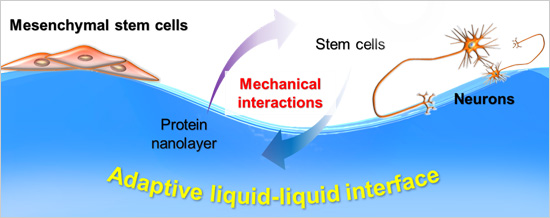Differentiation of Stem Cell into Neurons on an Interfacial Protein Nanolayer
—Deformable and Dynamic Scaffolds Can Offer an Alternative Approach in Regenerative Medicine to Regulate Stem Cell Differentiation without Expensive Reagents—
2019.12.10
National Institute for Materials Science (NIMS)
NIMS has succeeded in induction of stem cell differntiation into neurons on the surface of a protein nanolayer formed between two immiscible liquids (water and a perfluorocarbon liquid) without using expensive reagents. This technique is capable of regulating stem cell differentiation at low cost and may be valuable in regenerative medicine and other related fields.
Abstract
- NIMS has succeeded in induction of stem cell differntiation into neurons on the surface of a protein nanolayer formed between two immiscible liquids (water and a perfluorocarbon liquid) without using expensive reagents. This technique is capable of regulating stem cell differentiation at low cost and may be valuable in regenerative medicine and other related fields.
- Stem cells, including iPS cells, have been playing a vital role in regenerative medicine and tissue engineering. In these fields, techniques that can be used to efficiently promote stem cell differentiation into desired cell types are highly valuable. Although differentiation-inducing factors (DIFs), such as cytokines, have generally been used for this purpose, they are very expensive. Attempts have been made to control stem cell differentiation without using these reagents by controlling the stiffness and topography of cell culture substrates. However, this approach is inefficient in inducing stem cell differentiation. Therefore, a great deal of interest exists in developing new techniques to resolve these issues.
- The NIMS research team recently succeeded in developing a technique in which an interface between two immiscible liquids (an aqueous cell culture medium and a perfluorocarbon liquid (a type of oil)) is used as a platform for culturing and inducing differentiation of stem cells. At this interface, proteins involved in the cell culture medium self-assemble into a nanolayer sheet together with externally added fibronectin, a protein. The mesenchymal stem cells cultured on the surface of the nanolayer were confirmed to differentiate into neurons without adding DIFs. Culturing cells at a liquid-liquid interface is an innovative approach given that cells are normally cultured using solid materials, such as plastics. However, the team found that the use of a liquid interface is essential as it allows the formation of an adaptive nanolayer capable of deforming and remodeling in response to cellular mechanical forces, thereby facilitating efficient cell differentiation into neurons.
- In future research, the team plans to expand on this study and pursue the development of techniques that can be used to differentiate stem cells into various types of cells with additives other than fibronectin and different liquids. These techniques may offer new ways of creating cellular materials needed in regenerative medicine.
- This project was carried out by a research team led by Xiaofang Jia (Postdoctoral Fellow, International Center for Materials Nanoarchitectonics (MANA), NIMS), Jun Nakanishi (Group Leader, MANA, NIMS) and Katsuhiko Ariga (Principal Investigator, MANA, NIMS; also Professor, Graduate School of Frontier Sciences, University of Tokyo).
This research will be published in the online version of Advanced Materials at 12:00 pm on December 9, 2019, local time (8:00 pm on December 9, Japan Time).

figure: Mesenchymal Stem Cells Differentiate into Neurons at An Adaptive Liquid-Liquid Interface
Related files
- MANA
Contacts
(Regarding this research)
-
Jun Nakanishi
Group Leader,
Mechanobiology Group,
Nano-System Field,
International Center for Materials Nanoarchitectonics,
National Institute for Materials Science (NIMS)
Tel: +81-29-860-4569
FAX: +81-29-860-4706
E-Mail: NAKANISHI.Jun=nims.go.jp
(Please change "=" to "@") -
Katsuhiko Ariga
MANA Principal Investigator,
Group Leader,
Supermolecules Group,
Nano-Materials Field,
International Center for Materials Nanoarchitectonics,
National Institute for Materials Science (NIMS)
Professor,
Graduate School of Frontier Sciences
University of Tokyo
Tel: +81-29-860-4597
FAX: +81-29-860-4832
E-Mail: ARIGA.Katsuhiko=nims.go.jp
(Please change "=" to "@")
(General information)
-
Public Relations Office
National Institute for Materials Sciences
Tel: +81-29-859-2026
Fax: +81-29-859-2017
E-Mail: pressrelease=ml.nims.go.jp
(Please change "=" to "@")
Same Keywords
-
Development of a Self-Assembled Particle Gel for Promoting Blood Vessel Formation
(cell,regenerative medicine)
2020.07.06
-
Simultaneous Imaging of Intracellular DNA and RNA Using Harmless Light
(cell)
2025.10.27
-
Successful Cultivation of Stem Cells on the Surface of Ionic Liquids
(mechanobiology)
2024.02.28
Recent Press Release
-
Simultaneous Imaging of Intracellular DNA and RNA Using Harmless Light
2025.10.27
-
Development of an AI Device Using Ion Gel and Graphene That Dramatically Streamlines Machine Learning Computations
2025.10.14
-
Demonstrating a Novel Method to Modulate Heat Flow Through the Collective Motion of Spins
2025.10.06
